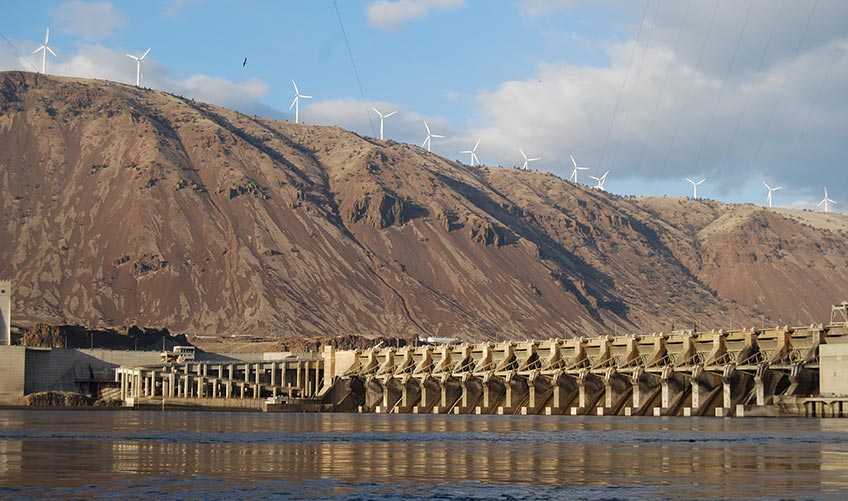HydroWIRES Pinpoints Key Design Elements of Tomorrow's Power System
This is not your parents' hydropower.
Today’s hydropower technologies do so much more than generate electricity.
In fact, hydropower may be the missing puzzle piece that offers the flexibility and storage necessary to effectively bridge the gap between traditional and renewable resources on the grid.
Because of its promising potential, the U.S. Department of Energy (DOE) Water Power Technologies Office introduced the Hydropower and Water Innovation for a Resilient Electricity System (HydroWIRES) Initiative, and the National Renewable Energy Laboratory (NREL) is playing a leading role in this effort.
This new grid research initiative aims to boost hydropower and pumped-storage hydropower’s (PSH) contributions to the reliability, resilience, and integration of tomorrow’s power systems.
It is well known that as the electric grid evolves, hydropower and PSH can offer much needed flexibility. However, the specific designs and operational qualities that would prove most useful to the changing grid remain a mystery, and these unknowns can result in inefficiencies that are often costly.
This is where HydroWIRES comes in.
Leveraging the expertise of five DOE national laboratories—NREL, Argonne National Laboratory, Idaho National Laboratory, Oak Ridge National Laboratory, and Pacific Northwest National Laboratory—HydroWIRES provides strategic insight and technical leadership to inform the R&D portfolio and broader DOE efforts in hydropower.
Comprising four research areas, HydroWIRES poses the following questions:
- What will the grid need?
- What can hydropower do?
- How can hydropower best align what it can do with what the grid will need?
- What new technology could expand what hydropower can do to meet grid needs?
NREL’s Role in Informing the Grid of Tomorrow
NREL researchers are active in all four of the HydroWIRES research areas: Value Under Evolving System Conditions; Capabilities and Constraints; Operations and Planning; and Technology Innovation.
NREL leads the five-lab consortium on research area three, which focuses on operations and planning. This work entails activities such as:
- Assessing hydropower’s contributions to the overall system reliability and resilience
- Providing context for hydropower’s unique costs and benefits, comparing it to other types of energy resources to inform planning decisions
- Improving operational strategies and tools to enable hydropower to optimize its operations to provide grid services
- Investigating the system effects of hydropower operations on water availability, emissions, environmental impacts, and more.
Through this comprehensive initiative, researchers are helping to determine how to best align today’s efforts with tomorrow’s grid needs.
Ramping up Renewables
It is clear that hydropower brings more to the table than just energy generation.
Because of its storage capabilities, many in the renewable energy industry are looking to hydropower to ramp up renewables on the grid, helping states and municipalities achieve their renewable portfolio standard benchmarks and low-carbon development goals.
Hydro offers high energy generation capacity and can provide medium- to long-term storage.
“With its ability to shift energy generation over weeks and months—and in some cases years—hydropower can serve as a conduit to expanding renewables on the grid now and in the years to come,” explained engineer Greg Stark, NREL’s hydropower technical lead.

And pumped-storage hydropower, in particular, is the largest source of energy storage on the grid.
But what does storage have to do with integrating renewable energy sources?
Renewables such as solar- or wind-generated energy are “variable generation resources,” meaning their energy production is dependent on a resource that cannot be directly stored and that can be difficult to predict (e.g., wind). When more wind or solar energy is generated than can be absorbed by the grid, energy production must be curtailed.
However, this is where pumped storage hydro excels. With its high power and extended duration capabilities, excess solar or wind energy can be stored for later use, increasing the viability of these energy sources on a larger scale, reducing energy losses, and lessening the grid’s reliance on fossil fuels.
“Storage has been a major roadblock to scaling up these types of renewable energy sources, and hydropower can help us to circumvent this barricade,” said Water Power Special Projects Lead Tessa Greco.
HydroWIRES and the NREL hydropower team are helping ensure that hydropower’s growing potential is realized and meeting the grid needs of tomorrow, today.
Learn more about HydroWIRES and NREL’s water research.
Last Updated May 28, 2025
